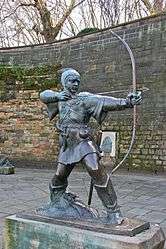Nottingham Royal Concert Hall
 The logo of the Royal Concert Hall, Nottingham | |
| Address |
South Sherwood Street Nottingham England |
|---|---|
| Owner | Nottingham City Council |
| Type | Concert Hall/Auditorium |
| Capacity | 2,499 (3 levels) |
| Current use | Touring Venue |
| Construction | |
| Opened | 27 November 1982 |
| Years active | Since 1982 |
| Architect | RHWL (Renton Howard Wood Levin Partnership) |
| Website | |
| http://www.trch.co.uk | |



Nottingham Royal Concert Hall is a concert hall in the English city of Nottingham. It is owned by Nottingham City Council and is part of a complex that also includes the city's Theatre Royal.[1] The Royal Concert Hall's striking modern architecture has proved to be a city landmark at the heart of Nottingham City Centre, opposite the more recently built The Cornerhouse complex.
The concert hall is served by the adjacent Royal Centre tram stop on the Nottingham Express Transit.[2]
History
The site of the Royal Concert Hall was previously the old 'Empire Palace of Varieties' designed and built in 1898 by Frank Matcham. The Empire closed for the last time in 1958 and was demolished for road-widening in 1969.[1]
Designed by the Renton Howard Wood Levin Partnership (architects of the Sheffield Crucible Theatre), the hall cost £12 million to complete. The project's client was Nottingham City Council, who were ambitious to win acclaim for their hall as a first-rate local, national and international venue for concerts and conferences.
Work on the Royal Concert Hall began in 1980 and was completed in 1982, providing Nottingham with a contemporary 2,499-seater, state-of-the-art, air-conditioned auditorium complete with a highly versatile sound and lighting system. The first artist to perform there was Elton John in November 1982.[1][3]
Architecture
"... the architects have attempted to keep before them a clear set of sculptural intentions. The development of the design has involved the production of some forty models and the overriding concern with the three-dimensional and fluid nature of the space has sought to give a new meaning to the old adage of architecture as 'frozen music'."
The acoustical design of the auditorium was created by reference to the standards of world-famous concert halls. An acoustical canopy (weighing 38 tonnes) can be raised and lowered and tilted backwards to suit the changing musical needs of each performance. At its lowest settings, the canopy suits intimate chamber music; higher settings suit louder performers.
The shimmering glass walls of the facade by day mirror the varied architecture nearby, acting as architectural 'sunglasses'. Whereas by night the effect of a display-case is created,those outside can see the audience inside dressed and assembling for their entertainment.
Notable artists
The Hall has become a leading venue on the worldwide touring circuit, regularly attracting world-class orchestras, rock bands, dance acts and solo artists, which includes Motörhead and Union J, who are both due to perform there later this year. The hall is also equipped for staging conferences and large meetings (for example in the late 1980s, it was the regular venue for BT's Annual General Meetings).
When the Royal Concert Hall first opened, Nottingham City Council entertained the idea of launching a resident professional orchestra to complement such a prestigious new venue but decided against it. There is still strong support for the idea and it is hoped by many that it may yet become a reality.
See also
References
- 1 2 3 "General Information - History". The Royal Centre. Archived from the original on 29 September 2010. Retrieved 18 October 2010.
- ↑ "Nottingham Express Transit : Tram Stops : Royal Centre". TheTrams.co.uk. Retrieved 18 August 2015.
- ↑ "About Us". Nottingham City Council. Retrieved 9 August 2016.
External links
- Official website
- Exterior photograph
- Interior photograph
- See the Royal Concert Hall on Google Street View
Coordinates: 52°57′20″N 1°9′5″W / 52.95556°N 1.15139°W
